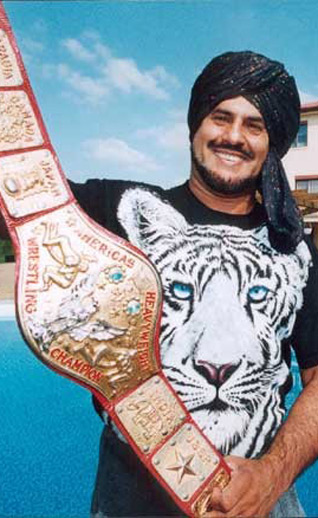Sports
The Sikh-Canadian Who Conquered Professional Wrestling:
Tiger Jeet Singh
RENJITH RAVINDRAN
Professional wrestling is an art and wrestlers are artists in the squared circles. The best part about being an artist is one cannot fail because it is a success just to be one.
People might forget you, they might forget what you did but then again, the things you do always have a place in history. All it takes is a fan to dig it out and shout to the world. And today, I’m going to be that fan, a fan that will dig out the brilliance of international star Tiger Jeet Singh.
The Rags to Riches Story of a Punjabi Boy
Tiger Jeet Singh’s career is something that will clearly give you goose-bumps.
Jagjeet Singh Hans was born on April 3, 1948, in Punjab. At the age of 17, he immigrated to Canada. Back then, he had two things: six dollars and a burning desire to become a wrestler.
Without any knowledge about wrestling except for what he saw on television, Jeet went to visit Frank Tunney who was a wrestling promoter in Toronto. Even though Jeet was pretty green at that time, Tunney decided to take him in because he saw money in a turbaned wrestler: the classic business move from a wrestling promoter.
Tunney introduced Jeet to Fred Atkins, who ended up training him to be a professional wrestler. Jeet soon entered the squared circle and during early parts of his career, he teamed up with his coach.
32 Stitches, a fainted wife and The Sheik
The first real success of Tiger Jeet Singh as a singles wrestler came back in 1967. He was booked against the then US Champion Johnny Valentine at the Maple Leaf Gardens in Toronto and it proved to be one of the shortest matches ever in the arena.
Once the opening bell rang, Jeet smashed the head of Valentine into the steel post near the ring. Valentine had his head busted open and needed 32 stitches, a gruesome sight which caused his wife, who was seated in the first row, to faint.
It was a blockbuster entry and the championship win made Jeet -- now hailed as The Tiger -- look legitimate. However, the money was a big problem in Toronto.
Tiger was struggling to meet ends so despite being a big star, he returned to Punjab where he had a comfortable life. Tiger’s absence, meanwhile, proved to be a blessing for The Sheik, who managed to establish himself as the top heel in Canada and fans loved to hate him.
And just like all the good stories, a villain needed a hero and Frank Tunney called Tiger to be the one.
In 1971, Tiger and Sheik squared off in the Maple Leaf Gardens for the first time. The match garnered a large crowd of 18,000 and considering that the average attendance was just 3500, it was a big jump to say the least.
Tiger, who used to make 100 dollars per match, made 6800 dollars. The night became more special for his wife, who gave birth to a baby boy.
The Tiger that Japan adopted
After his match against Sheik, Tiger’s market value skyrocketed. He wrestled all across the world against some big names and in 1972, he was invited to Japan.
And instead of working with smaller names in the country, Tiger was directly pitted up against Antonio Inoki. The crazed Punjabi, goes the legend, entered into a brawl with Inoki in a supermarket and beat up Inoki’s wife.
Inoki wanted to seek revenge for his wife and it presented the perfect storyline.
Inoki and Tiger feuded for years. The storyline saw its epitome when Inoki broke Tiger’s arm in 1974.
A year later, Tiger took revenge when he won the NWF world title from Inoki. And since Inoki was already a big star in the country, the feud worked in favor of Tiger as he became an icon in the nation.
He even had comic books in his name. Even now, Tiger is a legend in the country.
He went on to face a string of famous wrestlers which included the likes of Hulk Hogan, Abdulla the Butcher, Terry Funk, Andre the Giant, Giant Baba, Seiji Sakaguchi, Bruno Sammartino, Ric Flair, and Big Van Vader. He wasn’t just wrestling around, he won a plethora of championships as well and even defeated Ric Flair when Flair was shining as bright as the sun.
Life after retirement
Almost three decades of blood, sweat, and tears built up a strong bank balance for Tiger. His wife, who initially had a tough time dealing with her husband’s absence, started investing the money tactically.
Once Tiger was done with his career, he had a 14,000 sq ft. mansion which included a tennis court, swimming pool, Italian marble, sauna along with a farmland of 25 hectares. And if this was not enough, he has investments in many other business ventures.
Tiger is a keen philanthropist and is currently busy doing humanitarian work in Canada with the help of his foundation. He also has a public elementary school named after him for his contributions.
Despite all that he have achieved during his illustrious career, the name of Tiger Jeet Singh rarely pokes up among wrestling fans today. Is that because he didn’t wrestle much in the United States?
It’s a topic for debate, but Tiger has his own explanations for staying away from the States.
Japan, he says, was his favourite stomping ground because the Japanese fans feel honored to be in the presence of wrestlers. It is not just a sport for them, it’s something bigger, it’s an art.
And Tiger Jeet Singh was an artist they loved.
[Courtesy: Sports Keeda. Edited for sikhchic.com]
October 27, 2015



